-
Notifications
You must be signed in to change notification settings - Fork 0
Home
- Add Trackier SDK to your app
- Implement and initialize the SDK
- Defer Start Sdk
- Disable Organic Tracking
- Track Events
- Track Uninstall
- Proguard Settings
Add the code below to Module level app build.gradle before dependencies
repositories {
mavenCentral() //Please add this code to your module level build.gradle
}Below are the for screenshot reference.
Screenshot[1]
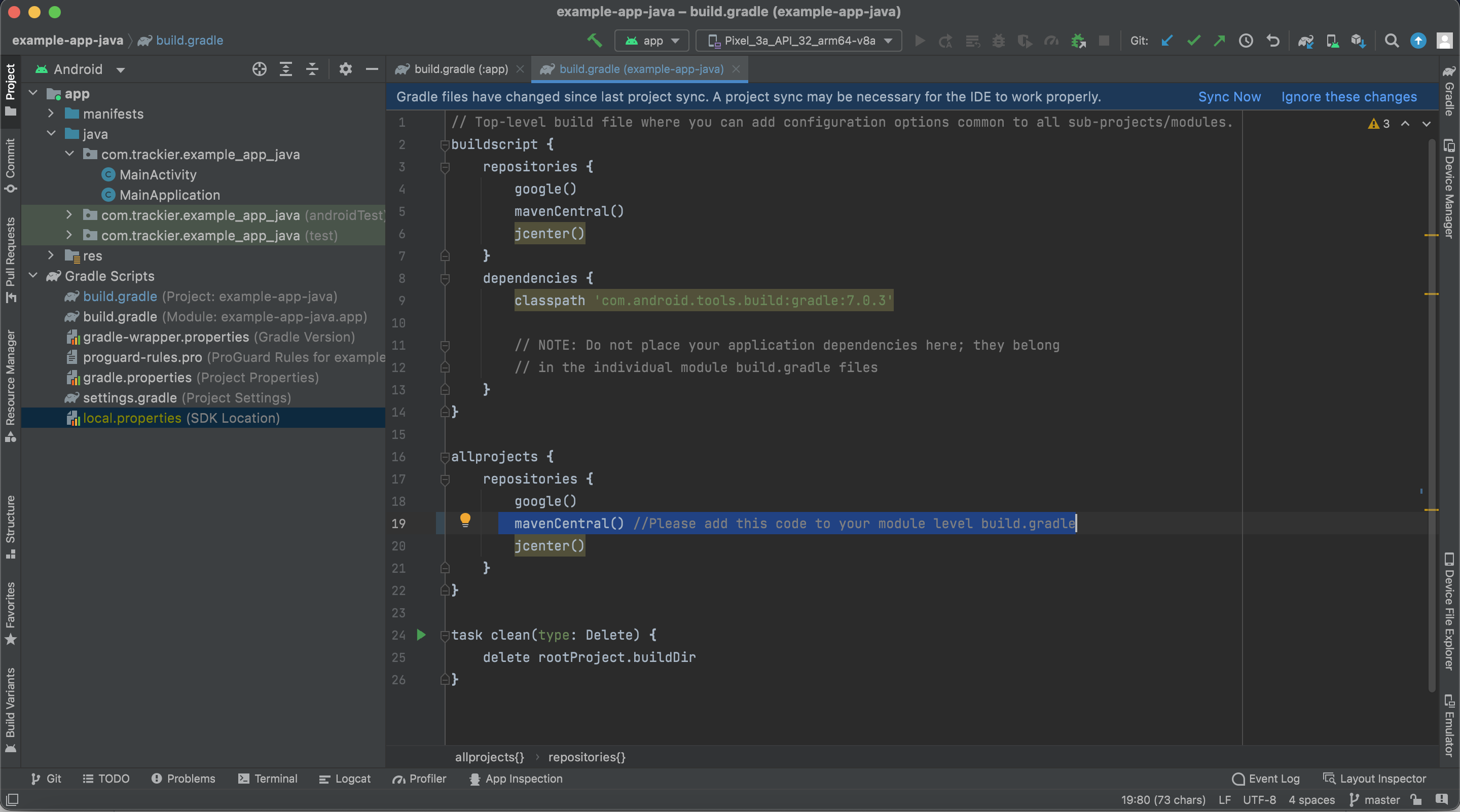
You can find the latest version here
implementation 'com.trackier:android-sdk:1.6.21' //Add this Trackier SDK dependency in the build.gradleAlso, please check the screenshot[2] in the below section for reference.
Add the Android Install Referrer as a dependency. You can find the latest version here
dependencies {
// make sure to use the latest SDK version:
// https://mvnrepository.com/artifact/com.trackier/android-sdk
implementation 'com.trackier:android-sdk:1.6.21' //Add this Trackier SDK dependency in the build.gradle
implementation 'com.android.installreferrer:installreferrer:2.2' //Add this install referrer dependency in the build.gradle
}Sync the project to retrieve the dependencies – see the following screenshot.
Screenshot[2]
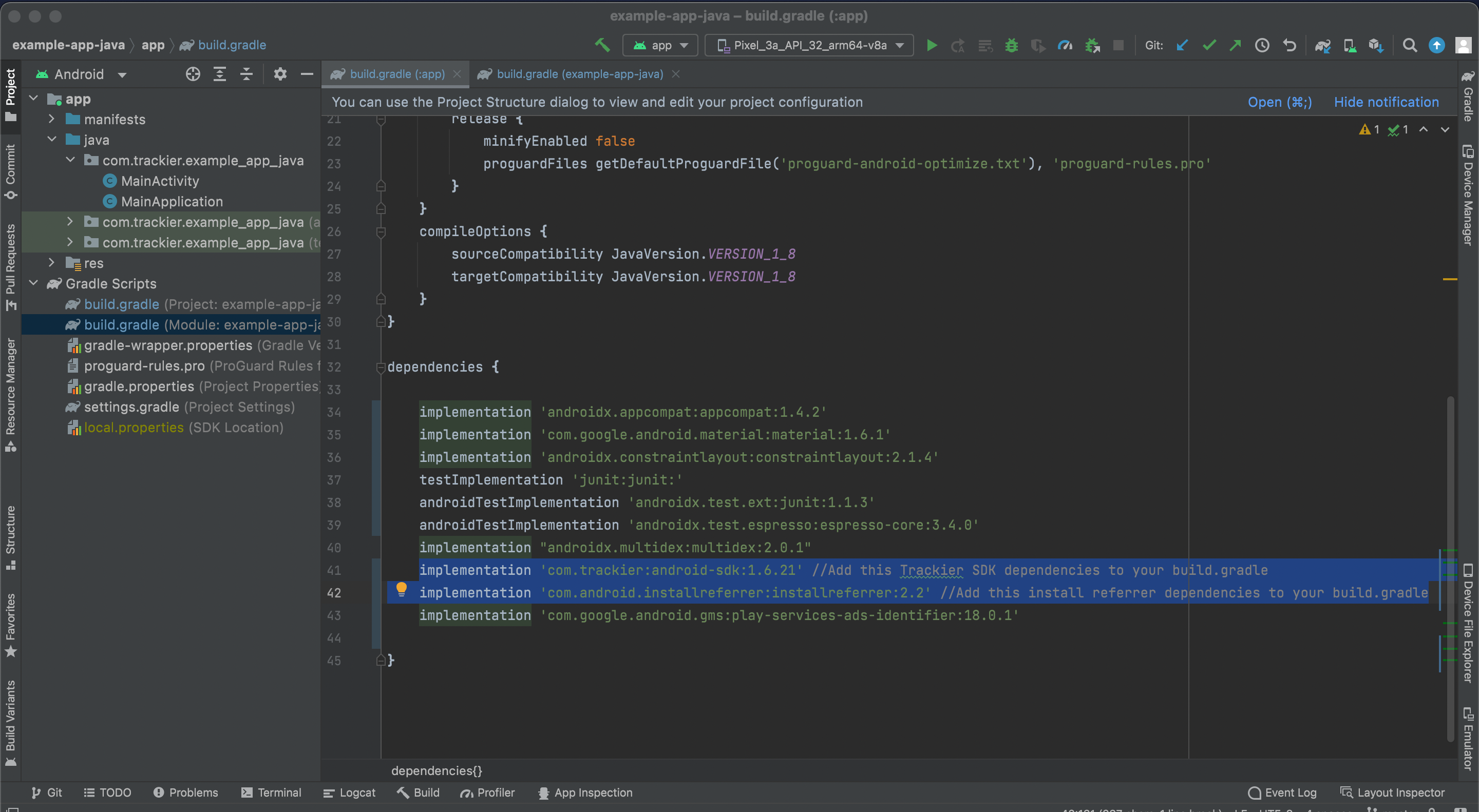
Trackier SDK need the following below permission in the manifest.xml.
Please add the below permission in your app project manifest.xml. if they are not added.
<uses-permission android:name="android.permission.INTERNET" />
<uses-permission android:name="android.permission.ACCESS_NETWORK_STATE" />
<uses-permission android:name="android.permission.ACCESS_WIFI_STATE" />
<!-- Optional : -->
<uses-permission android:name="android.permission.READ_PHONE_STATE" />Below are the Screenshot for the reference
Screenshot[3]
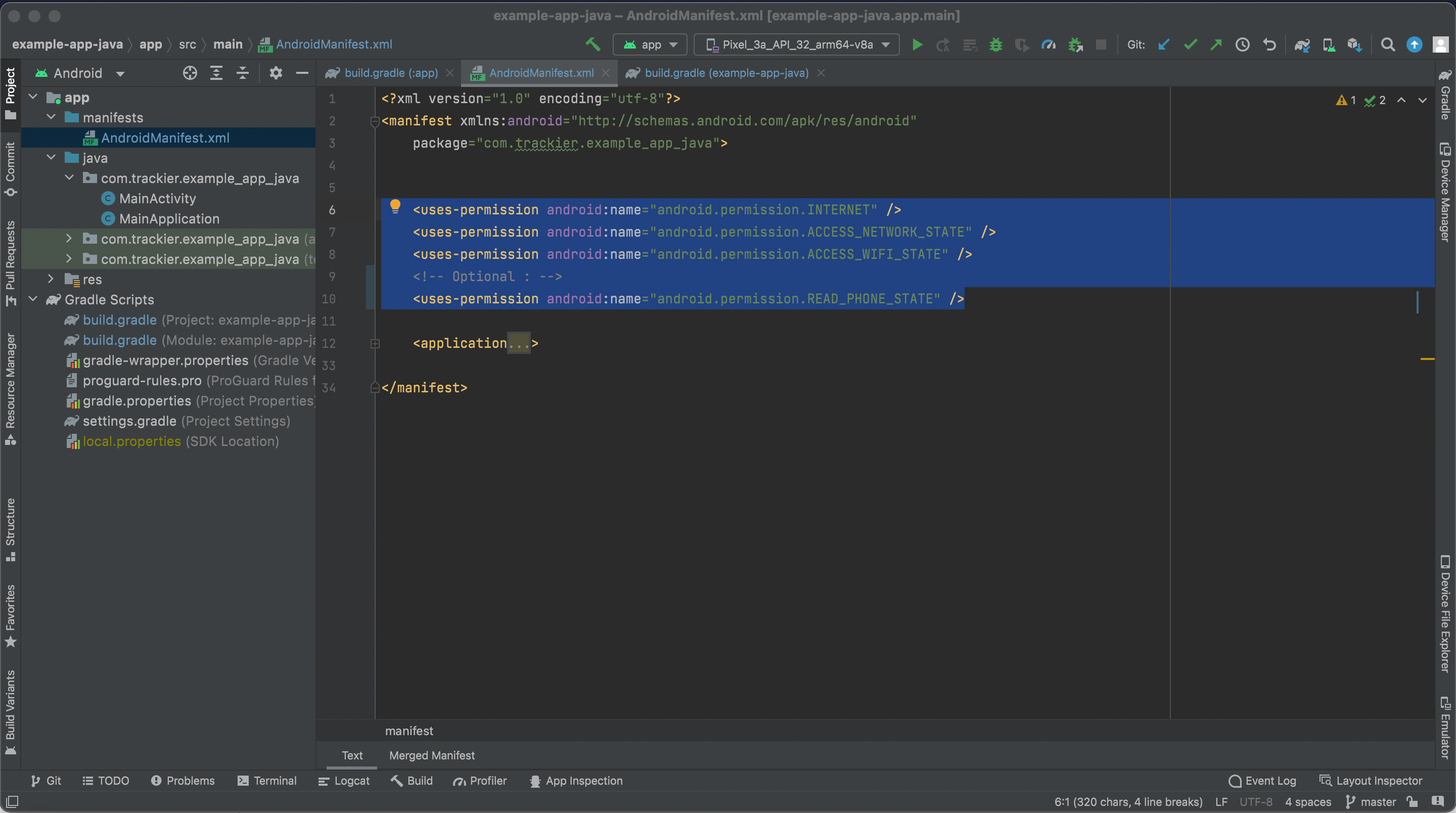
Trackier SDK need the advertising id from the application.
For achieving this, you need to add some line of code in the build.gradle and also in Manifest.xml for read the Advertising id from the application which is mentioned below
- Add the google advertising id dependency in your app build.gradle
dependencies {
// This can be added where the SDK dependency has been added
implementation 'com.google.android.gms:play-services-ads-identifier:18.0.1'
}Below are the Screenshot for the reference
ScreenShot[4]

- Update your Android Manifest file by adding the following permission. This is required if your app is targeting devices with android version 12+
<uses-permission android:name="com.google.android.gms.permission.AD_ID"/>- Add meta data inside the application tag (If not already added)
<meta-data
android:name="com.google.android.gms.version"
android:value="@integer/google_play_services_version" /> //Add this meta-data in the manifest.xml under Application tag.Below are the screenshot of application tag in manifest.xml for the reference
Screenshot[5]
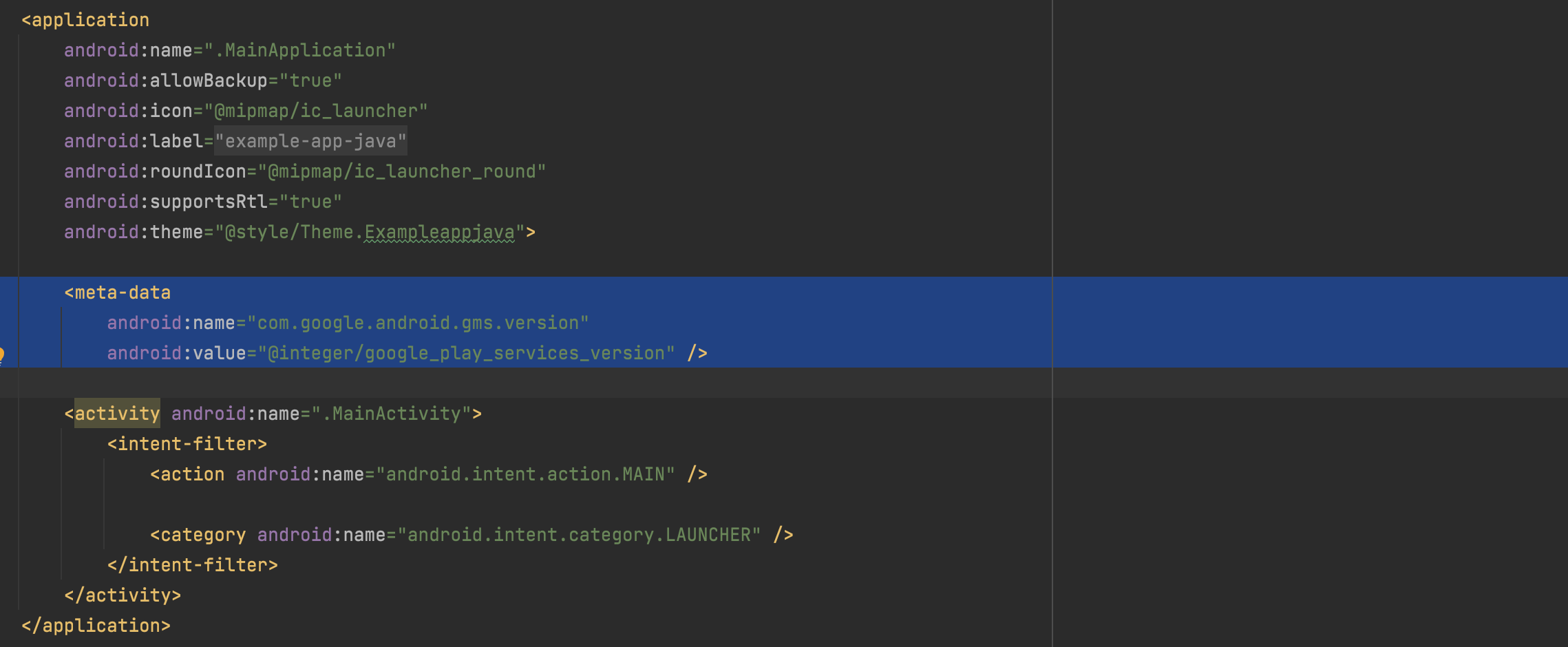
For initialising the Trackier SDk. First, We need to generate the Sdk key from the Trackier MMP panel.
Following below are the steps to retrieve the development key:-
- Login your Trackier Panel
- Select your application and click on Action button and login as
- In the Dashboard, Click on the
SDK Integrationoption on the left side of panel. - under on the SDK Integration, You will be get the SDK Key.
After follow all steps, Your SDK key look like the below screenshot
Screenshot[6]

We recommend initializing the SDK inside the app’s global application class. This allows the SDK to initialize in all scenarios, including deep linking.
For initializing the sdk in your app project. Add the initialize function code in the global application class.
If your project app does not have application class in your project. Follow the below steps
- Create a new class that extends the
Application - Open the
AndroidManifest.xmlfile of your project app and find the<application>elements - Add the attribute
android:nameand set it to the name of your new application class.
In our Trackier example app, we use Application class named as MainApplication.
We configured the manifest file as like mentioned in below:-
<application
android:name=".MainApplication"
android:allowBackup="true"
android:icon="@mipmap/ic_launcher"
android:label="@string/app_name"
android:roundIcon="@mipmap/ic_launcher_round"
android:supportsRtl="true"
android:theme="@style/Theme.Exampleappjava">
<meta-data
android:name="com.google.android.gms.version"
android:value="@integer/google_play_services_version" />
<activity android:name=".MainActivity">
<intent-filter>
<action android:name="android.intent.action.MAIN" />
<category android:name="android.intent.category.LAUNCHER" />
</intent-filter>
</activity>
</application>
After following the above steps, you need to add the following code in the MainApplication class under onCreate() method.
Check the below example code for the SDK initializations.
import com.trackier.sdk.TrackierSDK;
import com.trackier.sdk.TrackierSDKConfig;
public class MainApplication extends Application {
@Override
public void onCreate() {
super.onCreate();
final String TR_DEV_KEY = "XXXXXXX-XXXX-XXXX-80e3-5938fadff"; //Please pass your Development key here.
/*While Initializing the Sdk, You need to pass the three parameter in the TrackierSDKConfig.
* In First argument, you need to pass context of the application
* In second argument, you need to pass the Trackier SDK api key
* In third argument, you need to pass the environment which can be either "development", "production" or "testing". */
TrackierSDKConfig sdkConfig = new TrackierSDKConfig(this, TR_DEV_KEY,"development");
TrackierSDK.initialize(sdkConfig);
}
}
Screenshot for the above initializing code:-
Screenshot[7]
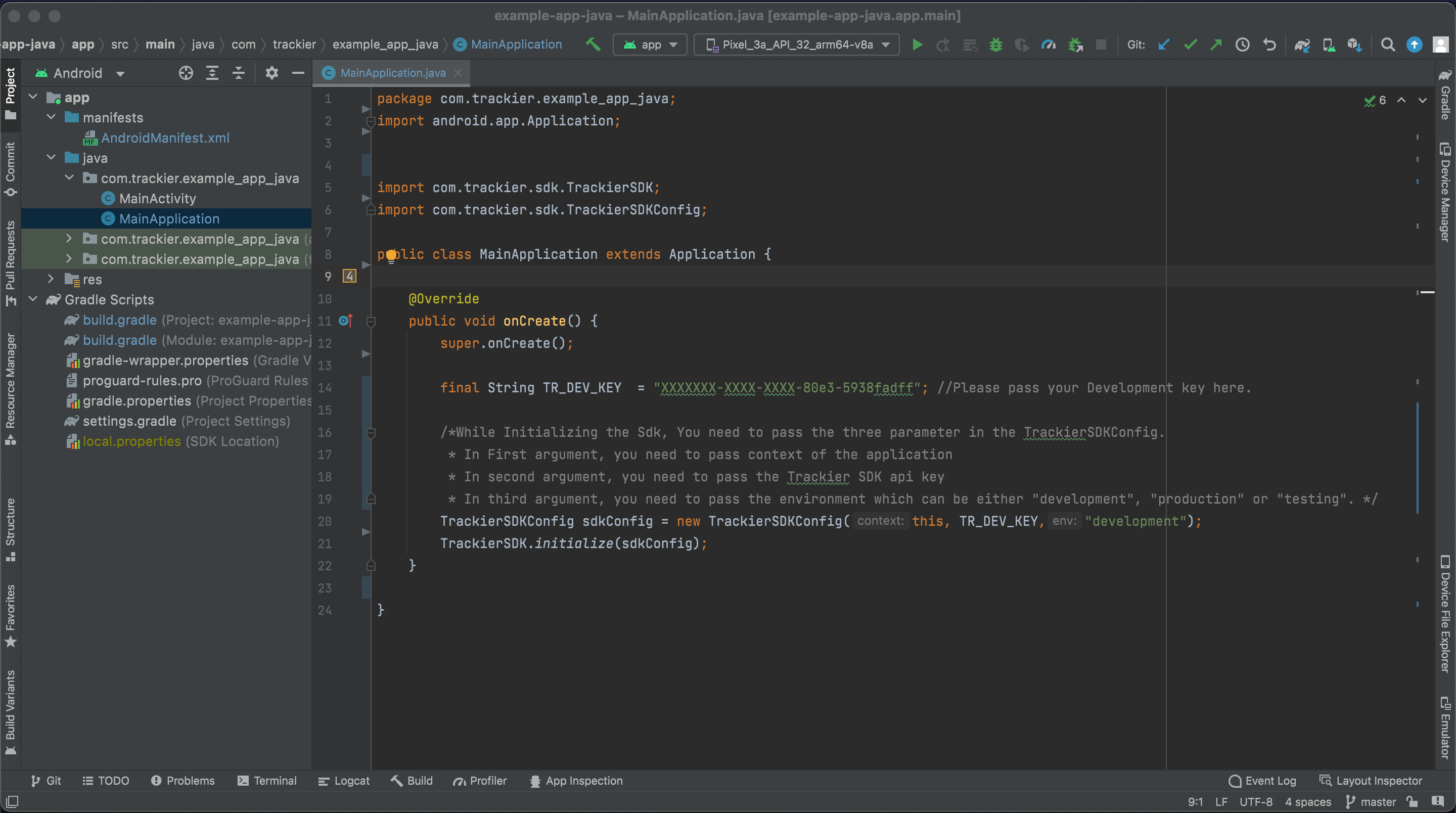
Important: it is crucial to use the correct dev key when initializing the SDK. Using the wrong dev key or an incorrect dev key impact all traffic sent from the SDK and cause attribution and reporting issues.
We recommend initializing the SDK inside the app’s global application class. This allows the SDK to initialize in all scenarios, including deep linking.
For initializing the sdk in your app project. Add the initialize function code in the global application class.
If your project app does not have application class in your project. Follow the below steps
- Create a new class that extends the
Application - Open the
AndroidManifest.xmlfile of your project app and find the<application>elements - Add the attribute
android:nameand set it to the name of your new application class.
In our Trackier example app, we use Application class named as MainApplication.
We configured the manifest file as like mentioned in below:-
<application
android:name=".MainApplication"
android:allowBackup="true"
android:icon="@mipmap/ic_launcher"
android:label="@string/app_name"
android:roundIcon="@mipmap/ic_launcher_round"
android:supportsRtl="true"
android:theme="@style/Theme.Exampleappkotlin">
<meta-data
android:name="com.google.android.gms.version"
android:value="@integer/google_play_services_version" />
<activity android:name=".MainActivity">
<intent-filter>
<action android:name="android.intent.action.MAIN" />
<category android:name="android.intent.category.LAUNCHER" />
</intent-filter>
</activity>
</application>
After following the above steps, you need to add the following code in the MainApplication class under onCreate() method.
Check the below example code for the SDK initializations.
import android.app.Application
import com.trackier.sdk.TrackierSDK
import com.trackier.sdk.TrackierSDKConfig
class MainApplication : Application() {
override fun onCreate() {
super.onCreate()
val TR_DEV_KEY: String = "xxxx-xx-4505-bc8b-xx" //Please pass your Development key here.
/*While Initializing the Sdk, You need to pass the three parameter in the TrackierSDKConfig.
* In First argument, you need to pass context of the application
* In second argument, you need to pass the Trackier SDK api key
* In third argument, you need to pass the environment which can be either "development", "production" or "testing". */
val sdkConfig = TrackierSDKConfig(this, TR_DEV_KEY, "development")
TrackierSDK.initialize(sdkConfig)
}
}
Screenshot for the above initializing code of Trackier example app:-
Screenshot[8]

Important: it is crucial to use the correct dev key when initializing the SDK. Using the wrong dev key or an incorrect dev key impact all traffic sent from the SDK and cause attribution and reporting issues.
Trackier events trackings enable to provides the insights into how to user interacts with your app. Trackier sdk easily get that insights data from the app. Just follow with the simple events integration process
Trackier provides the Built-in events and Customs events on the Trackier panel.
Built-in Events - Predefined events are the list of constants events which already been created on the dashboard. You can use directly to track those events. Just need to implements events in the app projects.
Screenshot[9]
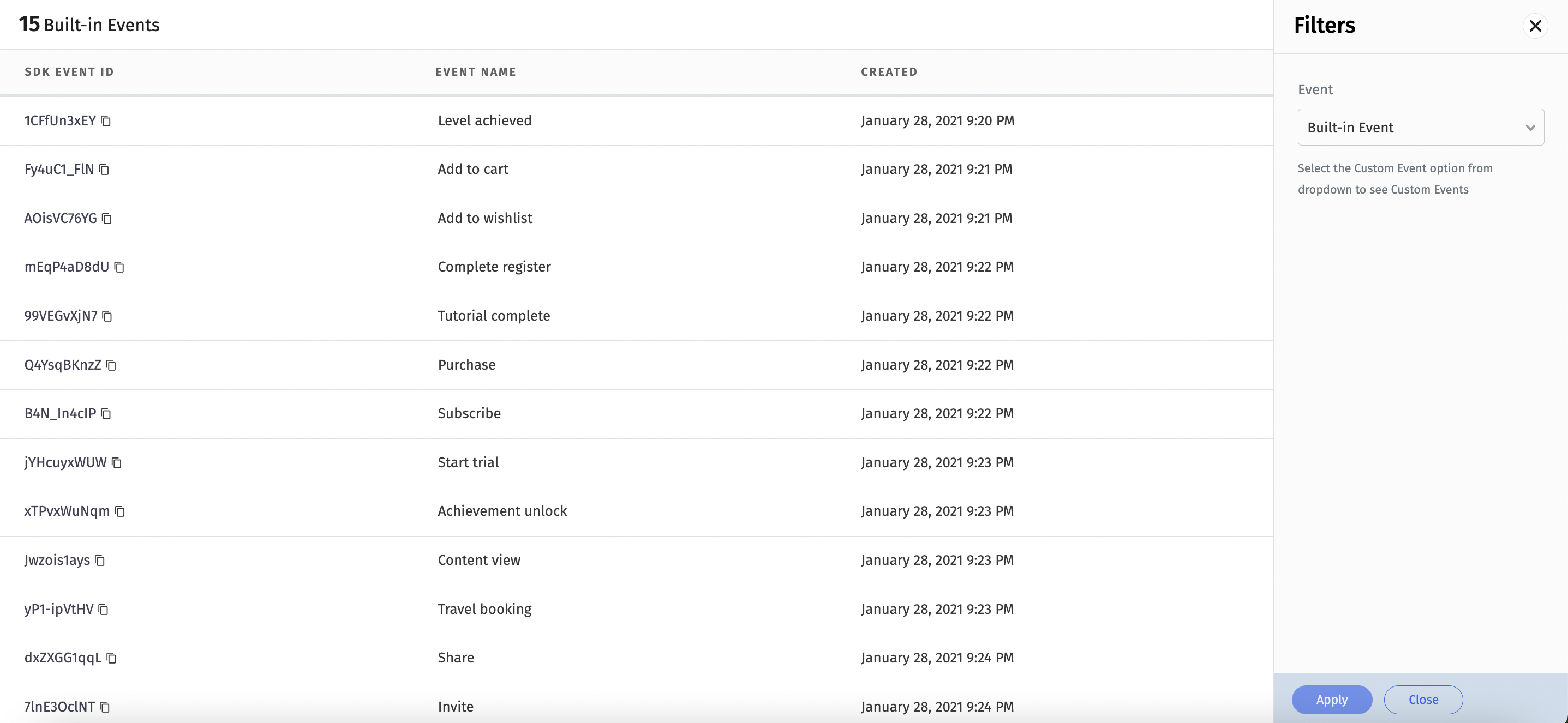
import androidx.appcompat.app.AppCompatActivity;
import android.os.Bundle;
import android.util.Log;
import android.view.View;
import android.widget.Button;
import com.trackier.sdk.TrackierEvent;
import com.trackier.sdk.TrackierSDK;
public class MainActivity extends AppCompatActivity {
Button eventTrack, eventTrackWithCurrency;
@Override
protected void onCreate(Bundle savedInstanceState) {
super.onCreate(savedInstanceState);
setContentView(R.layout.activity_main);
eventTrack =(Button) findViewById(R.id.event_track);
eventTrack.setOnClickListener(new View.OnClickListener() {
@Override
public void onClick(View view) {
eventsTracking();
}
});
}
private void eventsTracking(){
// Below are the example of built-in events function calling
//The arguments - "TrackierEvent.LOGIN" passed in the Trackier event class is Events id
TrackierEvent event = new TrackierEvent(TrackierEvent.LOGIN);
/*Below are the function for the adding the extra data,
You can add the extra data like login details of user or anything you need.
We have 10 params to add data, Below 5 are mentioned*/
event.param1 = "Param 1";
event.param2 = "Param 2";
event.param3 = "Param 3";
event.param4 = "Param 4";
event.param5 = "Param 5";
TrackierSDK.trackEvent(event);
Log.d("TAG", "onClick: event_track ");
}
}
Note:- Argument in Trackier event class is event Id.
You can integrate inbuilt params with the event. In-built param list are mentioned below:-
orderId, revenue, currency, param1, param2, param3 ,param4, param5, param6, param7, param8, param9, param10.
import android.os.*
import android.util.Log
import android.widget.Button
import androidx.appcompat.app.AppCompatActivity
import com.trackier.sdk.TrackierEvent
import com.trackier.sdk.TrackierSDK
class MainActivity : AppCompatActivity() {
override fun onCreate(savedInstanceState: Bundle?) {
super.onCreate(savedInstanceState)
setContentView(R.layout.activity_main)
val btn_event_track = findViewById(R.id.event_track) as Button
val btn_event_curr_track = findViewById<Button>(R.id.event_curr_track)
btn_event_track.setOnClickListener {
eventsTracking()
}
}
fun eventsTracking(){
// Below are the example of built-in events function calling
//The arguments - "TrackierEvent.LOGIN" passed in the Trackier event class is Events id.
val event = TrackierEvent(TrackierEvent.LOGIN)
/*Below are the function for the adding the extra data,
You can add the extra data like login details of user or anything you need.
We have 10 params to add data, Below 5 are mentioned*/
event.param1 = "Param 1";
event.param2 = "Param 2";
event.param3 = "Param 3";
event.param4 = "Param 4";
event.param5 = "Param 5";
TrackierSDK.trackEvent(event)
Log.d("TAG", "onClick: event_track ")
}
}
Note:- Argument in Trackier event class is event Id.
You can integrate inbuilt params with the event. In-built param list are mentioned below:-
orderId, revenue, currency, param1, param2, param3 ,param4, param5, param6, param7, param8, param9, param10.
Customs Events - Customs events are created by user as per their required business logic. You can create the events in the Trackier dashboard and integrate those events in the app project.
Screenshot[10]
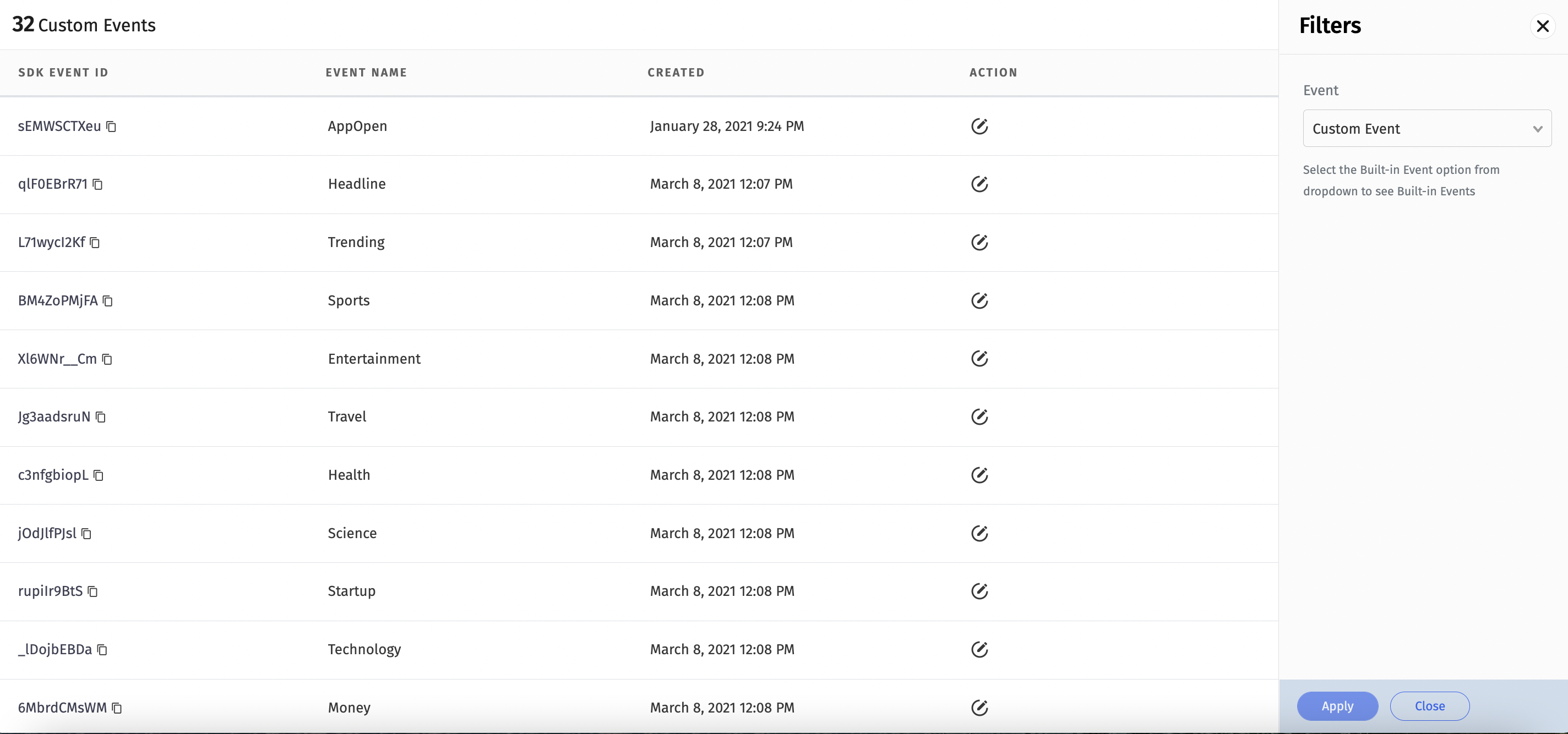
import androidx.appcompat.app.AppCompatActivity;
import android.os.Bundle;
import android.util.Log;
import android.view.View;
import android.widget.Button;
import com.trackier.sdk.TrackierEvent;
import com.trackier.sdk.TrackierSDK;
public class MainActivity extends AppCompatActivity {
Button eventTrack;
@Override
protected void onCreate(Bundle savedInstanceState) {
super.onCreate(savedInstanceState);
setContentView(R.layout.activity_main);
eventTrack =(Button) findViewById(R.id.event_track);
eventTrack.setOnClickListener(new View.OnClickListener() {
@Override
public void onClick(View view) {
customEventsTracking();
}
});
}
private void customEventsTracking(){
// Below are the example of customs events function calling
//The arguments - "sEMWSCTXeu" passed in the event class is Events id
TrackierEvent event = new TrackierEvent("sEMWSCTXeu");
/*Below are the function for the adding the extra data,
You can add the extra data like login details of user or anything you need.
We have 10 params to add data, Below 5 are mentioned*/
event.param1 = "Param 1";
event.param2 = "Param 2";
event.param3 = "Param 3";
event.param4 = "Param 4";
event.param5 = "Param 5";
TrackierSDK.trackEvent(event);
Log.d("TAG", "onClick: event_track ");
}
}
mport android.os.*
import android.util.Log
import android.widget.Button
import androidx.appcompat.app.AppCompatActivity
import com.trackier.sdk.TrackierEvent
import com.trackier.sdk.TrackierSDK
class MainActivity : AppCompatActivity() {
override fun onCreate(savedInstanceState: Bundle?) {
super.onCreate(savedInstanceState)
setContentView(R.layout.activity_main)
val btn_event_track = findViewById(R.id.event_track) as Button
val btn_event_curr_track = findViewById<Button>(R.id.event_curr_track)
btn_event_curr_track.setOnClickListener {
customEventsTrcking()
}
}
fun customEventsTrcking() {
// Below are the example of customs events function calling
//The arguments - "sEMWSCTXeu" passed in the event class is Events id
val event = TrackierEvent("sEMWSCTXeu")
/*Below are the function for the adding the extra data,
You can add the extra data like login details of user or anything you need.
We have 10 params to add data, Below 5 are mentioned*/
event.param1 = "Praram Name";
event.param2 = "Param 2";
event.param3 = "Param 3";
event.param4 = "Param 4";
event.param5 = "Param 5";
TrackierSDK.trackEvent(event)
Log.d("TAG", "onClick: event_curr_track ")
}
}
Trackier allow user to pass the revenue data which is generated from the app through Revenue events.
It is mainly used to keeping record of generating revenue from the app and also you can pass currency as well.
public class MainActivity extends AppCompatActivity {
Button eventTrack;
@Override
protected void onCreate(Bundle savedInstanceState) {
super.onCreate(savedInstanceState);
setContentView(R.layout.activity_main);
eventTrack =(Button) findViewById(R.id.event_track);
eventTrack.setOnClickListener(new View.OnClickListener() {
@Override
public void onClick(View view) {
revenueEventsTracking();
}
});
}
private void revenueEventsTracking(){
// Below are the example of inbuilt events function calling
//The arguments - "TrackierEvent.LOGIN" passed in the event class is Events id
TrackierEvent event = new TrackierEvent("sEMWSCTXeu");
//Passing the revenue events be like below example
event.revenue = 2.5; //Pass your generated revenue here.
event.currency = "USD"; //Pass your currency here.
TrackierSDK.trackEvent(event);
Log.d("TAG", "onClick: event_track ");
}
}
class MainActivity : AppCompatActivity() {
override fun onCreate(savedInstanceState: Bundle?) {
super.onCreate(savedInstanceState)
setContentView(R.layout.activity_main)
val btn_event_track = findViewById(R.id.event_track) as Button
val btn_event_curr_track = findViewById<Button>(R.id.event_curr_track)
btn_event_curr_track.setOnClickListener {
revenueEventsTrcking()
}
}
fun revenueEventsTrcking() {
// Below are the example of customs events function calling
//The arguments - "sEMWSCTXeu" passed in the event class is Events id
val event = TrackierEvent("sEMWSCTXeu")
//Passing the revenue events be like below example
event.revenue = 2.5 //Pass your generateed revenue here.
event.currency = "USD" //Pass your currency here.
TrackierSDK.trackEvent(event)
Log.d("TAG", "onClick: event_curr_track ")
}
}
private void customEventsTracking(){
// Below are the example of inbuilt events function calling
//The arguments - "TrackierEvent.LOGIN" passed in the event class is Events id
TrackierEvent event = new TrackierEvent("sEMWSCTXeu");
//Passing the extra data through customs params
HashMap<String,Object> eventCustomParams= new HashMap<>();
eventCustomParams.put("customParam1","xxxxxx");
eventCustomParams.put("customParam2","xxxxxx");
event.ev = eventCustomParams; //Pass the reference to the ev
TrackierSDK.trackEvent(event);
Log.d("TAG", "onClick: event_track ");
}- First create a mutable map
- Pass its reference to event.ev param of event
- Pass event reference to trackEvent method of TrackerSDK
Trackier allows to pass additional data like Userid, Email to SDK so that same can be correlated to the Trackier Data and logs.
Just need to pass the data of User Id, Email Id and other additional data to Trackier sdk function which is mentioned below:-
import androidx.appcompat.app.AppCompatActivity;
import android.os.Bundle;
import android.widget.Button;
import com.trackier.sdk.TrackierSDK;
import java.util.HashMap;
public class MainActivity extends AppCompatActivity {
Button eventTrack, eventTrackWithCurrency;
@Override
protected void onCreate(Bundle savedInstanceState) {
super.onCreate(savedInstanceState);
setContentView(R.layout.activity_main);
userDetails();
}
private void userDetails(){
/*Passing the UserId and User EmailId Data */
TrackierSDK.setUserId("XXXXXXXX"); //Pass the UserId values here
TrackierSDK.setUserEmail("[email protected]"); //Pass the user email id in the argument.
/*Passing the additional data */
HashMap<String,Object> userDetails = new HashMap<>();
userDetails.put("Name","Sanu"); //You can pass the Username data.
userDetails.put("UserMobile","873287XXXX"); // You can pass user mobile number
TrackierSDK.setUserAdditionalDetails(userDetails);
}
}
import android.os.*
import androidx.appcompat.app.AppCompatActivity
import com.trackier.sdk.TrackierSDK
class MainActivity : AppCompatActivity() {
override fun onCreate(savedInstanceState: Bundle?) {
super.onCreate(savedInstanceState)
setContentView(R.layout.activity_main)
userDetails()
}
fun userDetails(){
/*Passing the UserId and UserEmail Data*/
TrackierSDK.setUserId("XXXXXXXX") //Pass the UserId values here
TrackierSDK.setUserEmail("[email protected]") //Pass the user email id in the argument.
/*Passing the Additional Data*/
val userAdditionalDetails: MutableMap<String,Any> = mutableMapOf()
userAdditionalDetails.put("UserName","ABC") //You can pass the Username data.
userAdditionalDetails.put("MobileNumber","8878328XXX") // You can pass user mobile number
TrackierSDK.setUserAdditionalDetails(userAdditionalDetails) //Pass the userAdditionalDetails reference in this method.
}
}
Trackier allow for passing the additional user details like UserName, Mobile Number, UserAge, UserGender etc. . You need to first make a hashmap and pass it in setUserAdditionalDetails function. The example are in mentioned below
import androidx.appcompat.app.AppCompatActivity;
import android.os.Bundle;
import android.widget.Button;
import com.trackier.sdk.TrackierSDK;
import java.util.HashMap;
public class MainActivity extends AppCompatActivity {
Button eventTrack, eventTrackWithCurrency;
@Override
protected void onCreate(Bundle savedInstanceState) {
super.onCreate(savedInstanceState);
setContentView(R.layout.activity_main);
userDetails();
}
private void userDetails(){
HashMap<String,Object> userDetails = new HashMap<>();
userDetails.put("Name","Sanu"); //You can pass the Username data.
userDetails.put("UserMobile","873287XXXX"); // You can pass user mobile number
TrackierSDK.setUserAdditionalDetails(userDetails);
}
}import android.os.*
import androidx.appcompat.app.AppCompatActivity
import com.trackier.sdk.TrackierSDK
class MainActivity : AppCompatActivity() {
override fun onCreate(savedInstanceState: Bundle?) {
super.onCreate(savedInstanceState)
setContentView(R.layout.activity_main)
userDetails()
}
fun userDetails(){
val userAdditionalDetails: MutableMap<String,Any> = mutableMapOf()
userAdditionalDetails.put("UserName","ABC") //You can pass the Username data.
userAdditionalDetails.put("MobileNumber","8878328XXX") // You can pass user mobile number.
TrackierSDK.setUserAdditionalDetails(userAdditionalDetails) //Pass the userAdditionalDetails reference in this method.
}
}
Trackier
private FirebaseAnalytics mFirebaseAnalytics;
FirebaseAnalytics mFirebaseAnalytics = FirebaseAnalytics.getInstance(this);
mFirebaseAnalytics.setUserProperty("ct_objectId", Objects.requireNonNull(TrackierSDK.getTrackierId())); - Add the above code to your app to set up a common identifier.
- Set the
app_removeevent as a conversion event in Firebase. - Use the Firebase cloud function to send uninstall information to Trackier MMP.
- You can find the support article here.
sdkConfig.setManualMode(true);
TrackierSDK.setLocalRefTrack(true,"_");
TrackierSDK.initialize(sdkConfig); sdkConfig.setManualMode(true)
TrackierSDK.setLocalRefTrack(true,"_")
TrackierSDK.initialize(sdkConfig)- Set manual mode to true by passing true boolean value to setManualMode.
- The second method is to associate user email in which .
Note:- Make sure to take EXTERNAL_STORAGE_READ permission before enabling this feature. For reference you can see example directory
Now you can explicitly fire Install whenever desired,
TrackierSDK.fireInstall(); TrackierSDK.fireInstall() TrackierSDKConfig sdkConfig = TrackierSDKConfig(this, TR_DEV_KEY, "production");
sdkConfig.disableOrganicTracking(true);
TrackierSDK.initialize(sdkConfig); val sdkConfig = TrackierSDKConfig(this, TR_DEV_KEY, "production")
sdkConfig.disableOrganicTracking(true)
TrackierSDK.initialize(sdkConfig)If your app is using proguard then add these lines to the proguard config file
-keep class com.trackier.sdk.** { *; }
-keep class com.google.android.gms.common.ConnectionResult {
int SUCCESS;
}
-keep class com.google.android.gms.ads.identifier.AdvertisingIdClient {
com.google.android.gms.ads.identifier.AdvertisingIdClient$Info getAdvertisingIdInfo(android.content.Context);
}
-keep class com.google.android.gms.ads.identifier.AdvertisingIdClient$Info {
java.lang.String getId();
boolean isLimitAdTrackingEnabled();
}
-keep public class com.android.installreferrer.** { *; }